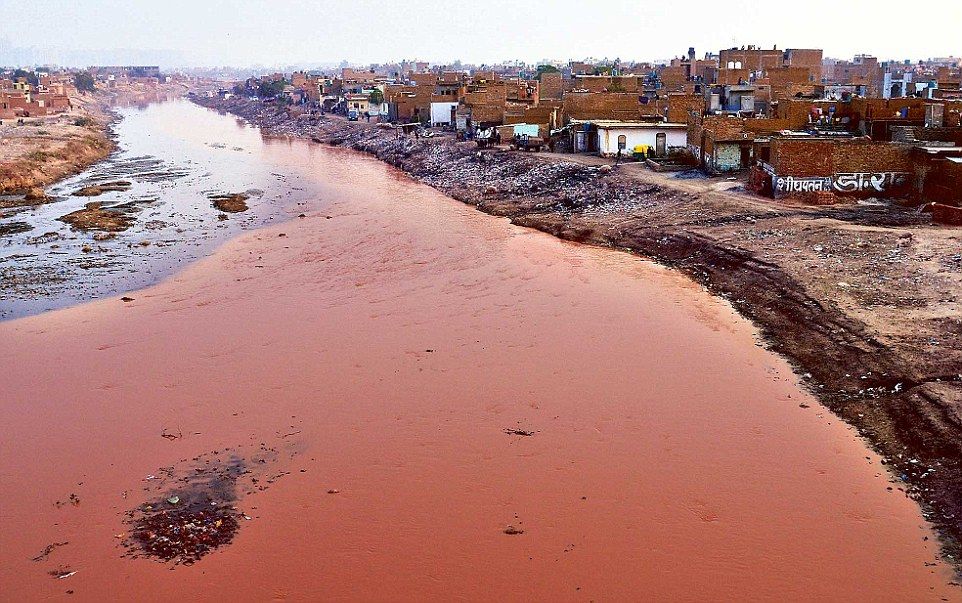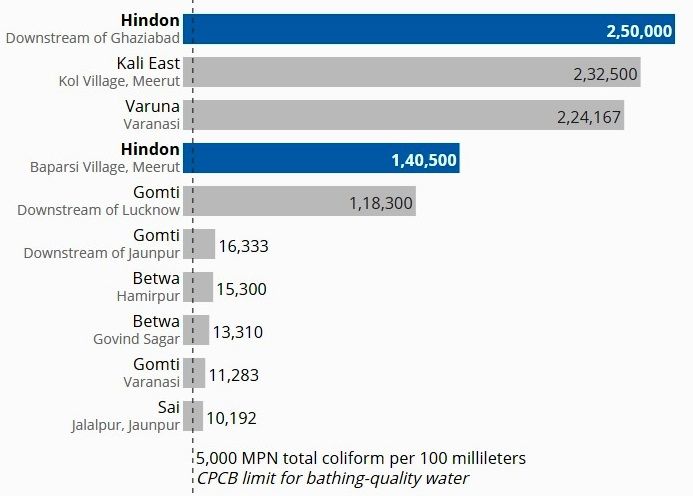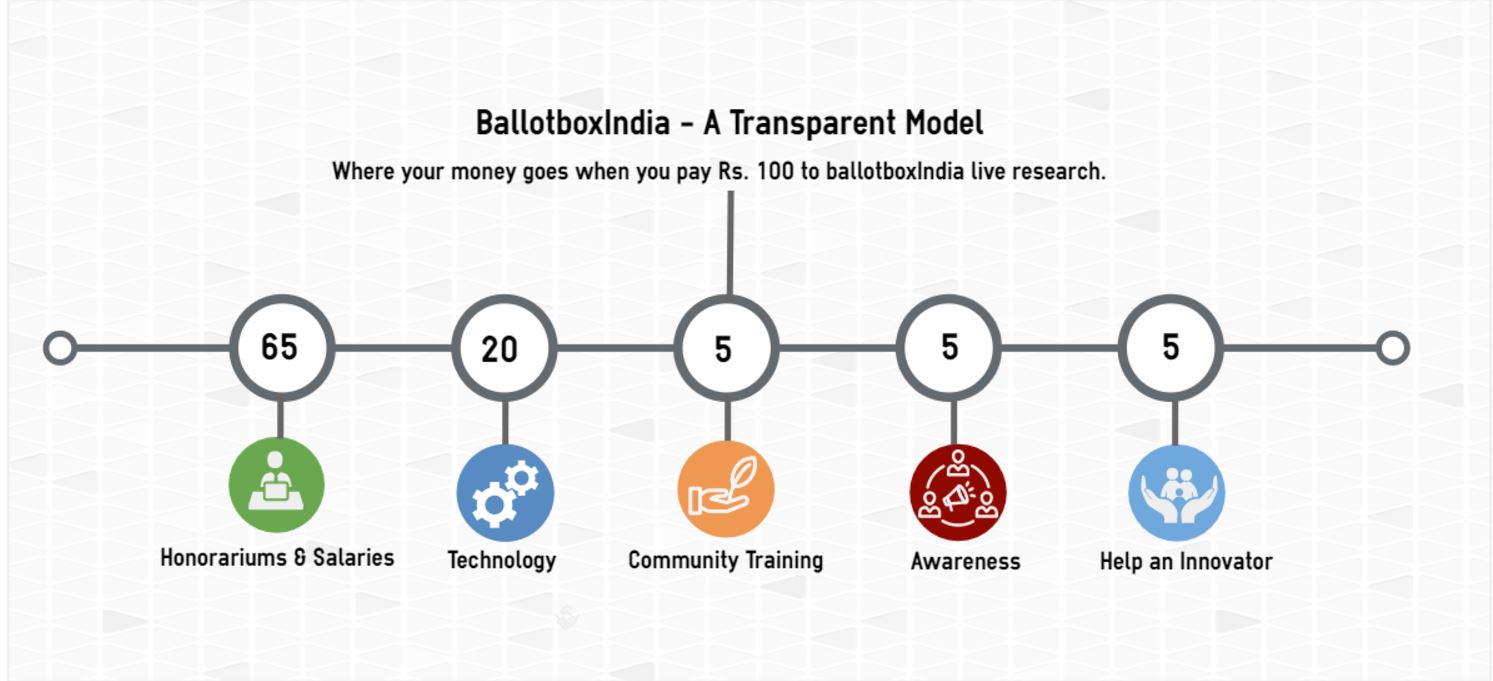Governments do not worry as Rivers don't bring votes - Local activists
The right to safe water is a basic human right - United Nations
Hindon River, a tributary of Yamuna river, is a river in India that originates in the Saharanpur District from Upper Shivalik in Lower Himalayan Range, rendering life and providing sustainability while flowing down the several civilisations. But the river (as several others) is now on the verge of death as the toxic levels in the river water have reached the extreme levels.
Hindon rises in Saharanpur district in the lower Himalayas
and flows between Ganges and Yamuna rivers, for 400 kilometres (250 mi) through
Muzaffarnagar District, Meerut District, Baghpat District, Ghaziabad, Noida,
Greater Noida before it joins Yamuna river just outside Delhi. It’s tributaries
(including the Kali River (West), and the Krishni River) flow through six
districts of Uttar Pradesh, before its confluence with the Yamuna River. A
highly populated and predominantly rural catchment, the Hindon River is heavily
utilized as a water resource for domestic, agricultural and industrial uses,
while untreated groundwater is the primary source of drinking water. The river
is entirely rainfed and has a catchment area of 7,083 square kilometres (2,735
sq mi).
Historical and Religious Significance
Hindon River, also known as Harnandi, is of both historical
as well as religious significance. Sardhana, a town on hindon river has an old
age Mahadev Temple that has existed since the era of Mahabharata and history
states that the Pandavas prayed here before starting their journey to the
Lakshagrih, the abode of lac created by Duryodhana. This temple exists at the
juncture of the Kali River, Kali Nadi and the Hindon River at Barnava.
It has an Indus valley civilisation site Alamgirpur is along
the river hindon. The hindon river was site for several skirmishes between
Indian troops and british soldiers in the first revolt of independence 1857
including the battle of Badli-ki-serai and the graves of british soldiers and
officers can still be seen.
It is strange that how a river that has so rich history around it has decimated in the hands of people and its natural life giving ability have been mutilated.
High Level of Contamination
Hindon river's extreme level of toxic contamination is
dragging eye balls of several water research organizations and researchers to
know the reasons behind its constant degrading. Mismanagement of the River
water has led to fatal contamination level and into the groundwater through the
catchment. A detailed health survey of the rural catchment population has
identified alarming levels of chronic illness and death which are directly
attributable to the presence of dangerously high toxic pesticide and heavy
metal contamination within the drinking water of these villagers.
In several studies conducted around the hindon river area
have revealed that a wide range of highly acutely toxic organochlorine and
organophosphorus pesticides and heavy metals are present in high levels in
river water and groundwater throughout the catchment that exceed all
international and national standards that declare its water unsafe for bathing
and drinking and any other household purposes.
Central pollution control board in its report in 2015 declared the river
‘unfit’ even for bathing.
Excessive use of pesticides and agricultural chemicals has
also contributed immensely in the river pollution. Organochlorine and
organophosphorus pesticides are shown to be entering water resources to toxic
levels as a result of over-application of agricultural chemicals.
In country like India rivers are considered nymph or goddesses and are considered holy. Taking a dip is believed to cure of all diseases and medical anomalies. They are addressed in every part of life, right from birth to death, when cremation ashes are immersed in river of the departed souls. Rivers in India bind people together; integrate cultures, communities and give people water for their daily lives. But the picture of Rivers has reversed in India in past few decades. Almost every river has suffered mutilation and is struggling for their survival. Be it Ganga, Yamuna, Gomti or any other. It just doesn’t shows the recklessness of our governments or awareness of people rather respect they have for the lifelines(rivers).
Major pollution is caused by the effluent discharge of the
industries on the bank of the river Hindon that dispose their industrial waste
directly into the river. Presence of heavy metals in the river water proves
that large volumes of industrial discharges are not treated before disposal. The
paper mills, sugar mills, distilleries, slaughter houses, dyeing and the
chemical industries have had unrestricted discharge of effluents directly to
the Hindon River.
The greatest tragedy is that this situation need never occur. Technology for effective industrial pollution control is available. Natural and sustainable farming methods are well established, yielding the desired results without the need for toxic chemicals. However, industrial pollution control technology is not being adequately installed, while sustainable farming methods are not being widely promoted by the authorities. The weakness that allows this situation to continue is therefore in the lack of implementation, and legal enforcement of effective pollution control.
Close to 400 villages were dependent on Hindon rivers water
until life providing water started giving chronic diseases that lead to death. Official
records say that 151 of the 400 villages on the banks of the river have
reported ailments like cancer, neurological and digestive disorders and skin
and respiratory infection due to the contaminated water. Locals living by or in
the areas have resented for the ailing river. They say- ‘deterioration started
when factories started coming in 1980s. Now the water is so polluted that it is
causing medical anomalies and people here consume more medicines than food.’
They blamed governments’ negligence as the ‘rivers don’t bring vote’.
From being a lifeline, Hindon River is now reduced to poison laden river that carry nothing more but death. Locals have objected and are relentless to vote unless authorities do something concrete to fix the condition the Hindon river.
Few years back the Hindon River’s roughly 30km stretch along the National Highway-24 in Ghaziabad had turned red due to the stone-crushing units operating on its banks and raising a health scare.

Image Source: Daily mail
The environmental activists allege that units are illegally operating on the river bank. These units fetch gigantic stones from hills, crush them into sand, use the Hindon’s water in the process, and then drain the effluent back into the river. Stone crushing units also discharge significant quantities of particle pollutants as well. Vikrant Tongad of NGO ‘Social Action for Forests & Environment’ had said to a newspaper "As per the rules laid down by the MoEF, non-farming and non-greening activities on a river bank are illegal. These stone crushing units are illegally extracting river water and throwing back discharge into the river. They have no permission from authorities like the Noida Authority, Ghaziabad Development Authority, UP Irrigation Department, Central Ground Water Authority or the UP Pollution Control Board”.
In a research it was found that the Hindon River is the most polluted river (tributary) in Uttar Pradesh. Central Pollution Control Board (CPCB) assessed the water quality of river Hindon and had said in their report that the river is not meeting the criteria with respect to Dissolved Oxygen, Conductivity, BOD(Biochemical Oxygen Demand), Total Coliform and Faecal Coliform. The Dissolved Oxygen as low as 0.4 mg/l has been observed downstream Saharanpur.
High level of BOD can be attributed to discharge of industrial effluents from number of electroplating and tannery units.
Coliform Bacteria are a commonly used indicator of sanitary quality of foods and water. The average total Coliform count (most probable number per 100 milliletres water) at Hindon River Water in 2014 was found to be 2,50,000 and CPC(Central pollution control board) limit is 5000 Most probable number(MPN) of total coliform per 100 millileters water for bathing.

Image source: Central pollution Control board, water quality data report 2014
Few conservation plans for the river Hindon have lost their
plot like much hyped Ganga and Yamuna action plans. Locals say that Just constructing ghats and beautifying the riverfront at some places will not help. Sixty industrial manufacturing units
are present along Hindon’s Kali and Krishna tributaries. Municipal drains of
Ghaziabad, Meerut, Kareda, Vasundhra, Pratap Vihar, Makreda and two at NH-24,
besides waste from one mortuary, are dumped into this river. They need to be
taken care first.
With rising pressure and resentment by civil society, the
state government was forced to wake up last year. Following an initiative by
waterman Rajendra Singh, chief minister Akhilesh Yadav launched an awareness
yatra for Hindon. A working group of planning commission visited the region to
setup the study of the river. Vouching the opportunity to mend the broken
belief at the times of elections, the government allocated Rs 2 Crore from the
budget for preliminary action plan.
Speaking in Lok Sabha on the rising level of pollution in
the Hindon River, a tributary of Yamuna river, the Union Minister Uma bharti
said that steps are being taken to control pollution level in the river. She
added that under the Yamuna Action Plan (YAP) Phase-I, the towns of Saharanpur,
Muzzafarnagar, Ghaziabad and Gautam Budhnagar located along Hindon have been
covered. Pollution abatement works pertaining to interception, diversion and
treatment of sewage, low cost sanitation, improved wood crematoria,
afforestation, public participation and awareness and amounting to Rs 159.35
crore have been implemented in these four towns to reduce the domestic
pollution load. A sewage treatment capacity of 269.5 million liters per day
(mld) has also been created in these towns under YAP Phase-I.
The pollution level has even alarmed the National Green Tribunal (NGT). The industry says it needs time to come up with a solution.On several speculations, Pankaj Aggarwal, industrialist and chairman of the Muzaffarnagar Municipal Board said, “we have promised to make the industries zero-discharge by March 31, 2017”.
What are we looking for:
The right to safe water is a basic human right, legally defined by the UN Committee on Economic, Social and Cultural Rights as follows; ‘The human right to water entitles everyone to sufficient, safe, acceptable, physically accessible and affordable water for personal and domestic uses’.
The legal definition of this human right reflects the requirement for water to be of adequate quality and not threaten the health of those who use it. India ranks 120th out of 122 countries in terms of water quality. At least 200 million Indian citizens do not have access to safe clean water, a violation of their human right. It is estimated that 90% of India’s water resources are contaminated with untreated industrial, domestic waste, pesticides and fertilizers. River ecosystems are of great environmental significance. Healthy riverine habitats support a unique and diverse array of species, a biological diversity that serves a number of social and
economic functions, such as providing a source of food.
Clean rivers are also essential for a range of non-domestic uses including crop
irrigation, hydropower energy generation, navigation and industrial uses. Clean
rivers also provide an enhanced landscape in which to live for an increased
quality of life. A polluted river is severely restricted in its ability to meet
any of the above functions.
The extreme toxic contamination of HindonRiver has reached
at unscalable height and the blighted health and early deaths of the villagers
who have no choice but to endure this toxicity. As is so often the case, it is
the poorest and most marginalized in society who is suffering worst from this
man-made environmental disaster. Medical expenses incurred by villagers as a
result of consuming contaminated drinking water are also shown to exert a heavy
economic burden on a population already economically and socially marginalized.
This action group is aimed at keep a track at the progress report of the Hindon River conservation project and the efforts made to restore the rivers health.
Do you want to chip in or add to this live research, Please click "Connect" button on this page, or write to coordinators@ballotboxindia.com
 tag on profile.
tag on profile.




